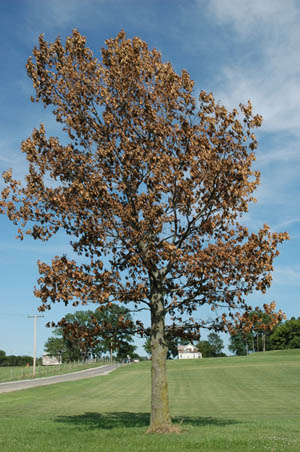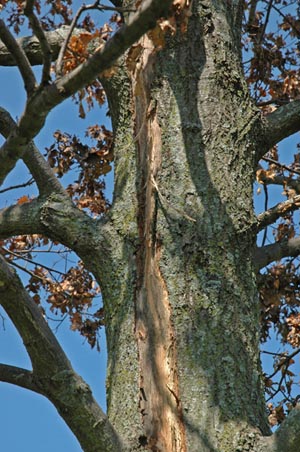Backyard Diagnosis | |
|---|---|
| July 25, 2008 | |
|
You don’t have to look far to find a good story about diagnosing a plant problem. Here is something that occurred at the University of Illinois Plant Clinic, in our own backyard. We have three good-sized red oaks at the Plant Clinic, planted when the lab first opened in the mid-1970s. Dave Williams of the Horticulture Department, along with some of his students, planted the trees. I know they were planted correctly, and all three have a nice trunk flare, no competing trees, and no heavy equipment moving over the roots. One of these oaks suddenly turned brown about the last week in June. Clinic staff helplessly watched this happen. The tree literally went from green to brown in about 4 days. The image shows this tree in early July.  Rains had been plentiful, and nearby trees were unaffected; so drought stress was out of the question. Red oak is very susceptible to oak wilt, so the oak wilt fungus was our first suspect. We sampled the tree but did not find any vascular discoloration. We went through the motions of culturing and incubating, but the oak wilt fungus did not appear. I happened to notice that the weeds around this tree were dead, whereas the weeds around the other two red oaks were green. I also noticed that the weeds around nearby utility poles were also dead. Had someone used a soil sterilant around the nearby pole and decided to control weeds around this tree too? That was my second guess. Fortunately, I did not make any accusations. I would have been wrong. About 3 weeks after the tree turned brown, we finally noticed that the bark on the back side of the tree had begun to fall off. When we walked around to the back side of the tree we saw what you see in this second image.  Quite obviously, this tree had been struck by lightning. The bark was not blown off with the lightning strike; but the cambium must have been “cooked,” eventually causing the bark to slough off to reveal the actual cause of the problem. The point of this story is to show that we don’t always recognize the problem immediately. Keep an open mind and realize that the diagnostic process is often a process of elimination and re-evaluation. It can be frustrating, but it is fun when you finally find the real cause of the problem. | |
| Author: | Nancy Pataky |
